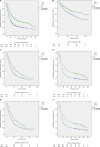Positive relationship between number of negative lymph nodes and duration of gallbladder cancer cause-specific survival after surgery
- PMID: 30588101
- PMCID: PMC6300379
- DOI: 10.2147/CMAR.S187857
Positive relationship between number of negative lymph nodes and duration of gallbladder cancer cause-specific survival after surgery
Abstract
Background: Although the prognostic implications of negative lymph nodes (NLNs) has been reported for a variety of tumors, little information has been published about the NLNs in gallbladder cancer (GBC).
Patients and methods: In this study, clinicopathological characteristics and survival times of patients who had undergone surgery for GBC were collected from the Surveillance, Epidemiology, and End Results Program-registered TNM stage database and analyzed. Univariate and multivariate Cox proportional hazards models were used to identify the predictors of survival.
Results: It was found that a cutoff of one to two NLNs is optimal when assessing the association with survival, survival rates being consistently better with two or more NLNs than with fewer than two. This optimal cutoff value of 2 was identified as an independent prognostic factor by univariate and multivariate analyses (all P<0.001). Specifically, patients with two or more NLNs had better 5-year gallbladder cancer cause-specific survival than those with fewer than NLNs examined for stage I/II, stage III/IV, and all TNM stages (all P<0.001).
Conclusion: Our findings indicate that the number of NLNs is an independent prognostic factor after GBC surgery, and, together with the number of positive lymph nodes, this will provide better prognostic information than the number of positive lymph nodes alone.
Keywords: SEER; gallbladder cancer; negative lymph nodes; surgery; survival analysis.
Conflict of interest statement
Disclosure The authors report no conflicts of interest in this work.
Figures

Similar articles
-
Number of negative lymph nodes can predict survival of breast cancer patients with four or more positive lymph nodes after postmastectomy radiotherapy.Radiat Oncol. 2014 Dec 16;9:284. doi: 10.1186/s13014-014-0284-5. Radiat Oncol. 2014. PMID: 25511525 Free PMC article.
-
Number of negative lymph nodes should be considered for incorporation into staging for breast cancer.Am J Cancer Res. 2015 Jan 15;5(2):844-53. eCollection 2015. Am J Cancer Res. 2015. PMID: 25973321 Free PMC article.
-
The Prognostic Value of the Number of Negative Lymph Nodes Combined with Positive Lymph Nodes in Esophageal Cancer Patients: A Propensity-Matched Analysis.Ann Surg Oncol. 2020 Jun;27(6):2042-2050. doi: 10.1245/s10434-019-08083-3. Epub 2020 Jan 2. Ann Surg Oncol. 2020. PMID: 31898102
-
Number of negative lymph nodes as a prognostic factor for ypN0-N1 breast cancer patients undergoing neoadjuvant chemotherapy.Tumour Biol. 2016 Jun;37(6):8445-54. doi: 10.1007/s13277-015-4640-3. Epub 2016 Jan 5. Tumour Biol. 2016. PMID: 26733172
-
Combined detection tumor markers for diagnosis and prognosis of gallbladder cancer.World J Gastroenterol. 2014 Apr 14;20(14):4085-92. doi: 10.3748/wjg.v20.i14.4085. World J Gastroenterol. 2014. PMID: 24744600 Free PMC article. Review.
Cited by
-
Effect of the number of negative lymph nodes removed on the survival and recurrence rate patients with non-small-cell lung cancer undergoing surgery: A multicenter retrospective cohort study.Medicine (Baltimore). 2025 May 2;104(18):e42402. doi: 10.1097/MD.0000000000042402. Medicine (Baltimore). 2025. PMID: 40324229 Free PMC article.
-
Comparative evaluation of negative lymph node count, positive lymph node count, and lymph node ratio in prognostication of survival following completely resection for non-small cell lung cancer: a multicenter population-based analysis.Front Surg. 2024 Dec 9;11:1506850. doi: 10.3389/fsurg.2024.1506850. eCollection 2024. Front Surg. 2024. PMID: 39717353 Free PMC article.
-
Examination of Prognostic Factors Affecting Long-Term Survival of Patients with Stage 3/4 Gallbladder Cancer without Distant Metastasis.Cancers (Basel). 2020 Jul 27;12(8):2073. doi: 10.3390/cancers12082073. Cancers (Basel). 2020. PMID: 32726993 Free PMC article.
-
Prognostic Evaluation for Patients over 45 Years Old with Gallbladder Adenocarcinoma Resection: A SEER-Based Nomogram Analysis.Biomed Res Int. 2020 Jul 18;2020:6370946. doi: 10.1155/2020/6370946. eCollection 2020. Biomed Res Int. 2020. PMID: 32733948 Free PMC article.
References
-
- Miller G, Jarnagin WR. Gallbladder carcinoma. Eur J Surg Oncol. 2008;34(3):306–312. - PubMed
-
- Garg PK, Pandey D, Sharma J. The surgical management of gallbladder cancer. Expert Rev Gastroenterol Hepatol. 2015;9(2):155–166. - PubMed
-
- Johnson PM, Porter GA, Ricciardi R, Baxter NN. Increasing negative lymph node count is independently associated with improved long-term survival in stage IIIB and IIIC colon cancer. J Clin Oncol. 2006;24(22):3570–3575. - PubMed
-
- Deng J, Liang H, Wang D, et al. Enhancement the prediction of postoperative survival in gastric cancer by combining the negative lymph node count with ratio between positive and examined lymph nodes. Ann Surg Oncol. 2010;17(4):1043–1051. - PubMed
LinkOut - more resources
Full Text Sources

